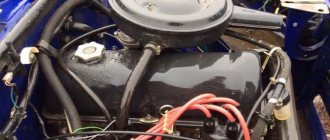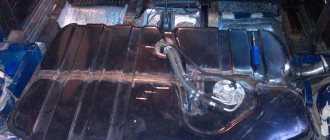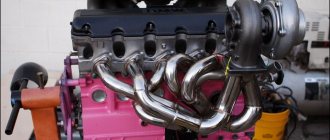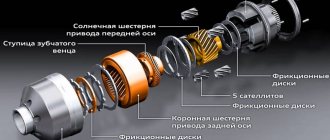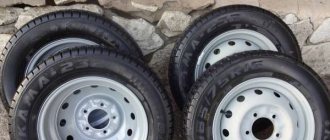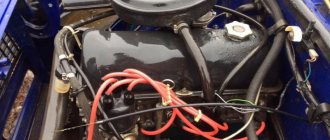Niva engine
Below is a list with a detailed description of the characteristics installed on the Niva with an index starting with 2121 and onwards. All Niva engines have an 8-valve engine with chain timing drive.
Engine 2121
The Niva got this internal combustion engine from the VAZ 2106, but, of course, it was modernized. Its volume was increased to 1.6 liters, which made it possible to remove a large amount of horsepower from the engine, which is so necessary for all-wheel drive. The engine was equipped with a two-chamber carburetor of increased volume, which also had a positive effect on the technical characteristics of the car. This engine was installed virtually unchanged until 2005; in 1995, the internal combustion engine underwent minor modifications, and its volume increased to 1.7 liters.
Specifications
| 1.6 liters until 1995 | 1.7 liters after 1995 to 2005 | |
| Type | Petrol | Petrol |
| Volume (cm3) | 1580 | 1696 |
| Power (hp) | 80 | 81 |
| Torque (Nm) | 116 | 129 |
| timing belt | Chain | Chain |
| Cooling | Liquid | Liquid |
| Number of valves | 8 | 8 |
| Number of cylinders | 4 | 4 |
| Supply system | Carburetor | Carburetor |
| Max. Speed (km/h) | 130 | 134 |
| Fuel consumption | 10,8 | 11,2 |
Engine 21214
In 2005, the Volga Automobile Plant, due to the introduction of EURO standards, switched to injection engines. This engine has an index of 21214 with an engine capacity of 1.7 liters and fuel injection using the distribution method through nozzles. This engine turned out to be quite successful and literally took the Niva to a new level. The injector made it possible to achieve more pleasant engine operation, easier starting and fuel economy. The engine continues to be produced to this day on Niva Urban and Niva 4x4 vehicles.
Specifications
| Type | Petrol |
| Volume (cm3) | 1696 |
| Power (hp) | 83 |
| Torque (Nm) | 127,5 |
| timing belt | Chain |
| Cooling | Liquid |
| Number of valves | 8 |
| Number of cylinders | 4 |
| Supply system | Injector |
| Max. Speed (km/h) | 134 |
| Fuel consumption | 9,1 |
Reliability, weaknesses, maintainability
Reliability
The problem of reliability is relevant for any engine. Every car owner is interested in a high-quality and at the same time economical engine for his car.
Unfortunately, in fact, the issue of reliability does not cause delight among some car enthusiasts. Others, on the contrary, are glad that their Niva has a VAZ-2121.
Car owners who take care of the engine consider it quite reliable. Well, those who, among all types of service, recognize only refueling with gasoline, have very doubts about the reliability of the engine.
Driving style and compliance with operating rules are of no small importance. For example, on one of the forums the author wrote this: “...then the ardor subsided and he stopped throwing money at her, and what I want to say is that the ride didn’t get any worse, but he stopped mocking her - he excluded extreme sports, so he’s holding on.”
Maxim from Sosnovy Bor also speaks positively about his engine: “...cheap to maintain, starts perfectly in any frost.”
To increase engine reliability, many car enthusiasts advise not to spare money on oil (buy only high-quality oil) and to replace it after 8-10 thousand kilometers.
For maintenance and minor repairs, it is recommended to use only original spare parts and consumables.
You need to fill your car with gasoline only at proven gas stations.
Promptly eliminate detected engine faults.
If you follow these simple operating rules, the motor will respond with high reliability and increased service life.
Weak spots
They are available in any engine. VAZ-2121 is no exception. At the same time, it must be borne in mind that the appearance of weak points is often provoked by the car owner himself.
Motor overheating. This kind of malfunction is not uncommon. A faulty thermostat, dirty radiator or water pump may be to blame. Sometimes it is enough to clean the radiator and the problem with engine cooling disappears. But the thermostat and pump will have to be changed.
Vibration of the internal combustion engine at idle speed in most cases occurs when using low-quality gasoline, as well as loss of shock-absorbing properties of the engine mounts. Less commonly, the cause is a damaged cylinder head gasket or burnt-out valves. If vibration occurs, the motor needs diagnostics at a car service center.
Increased camshaft wear. Unfortunately, this is a peculiar disease of all VAZ engines of the previous generation.
Some car enthusiasts are concerned about the significant oil consumption of the engine. As a rule, the main reason here is the use of cheap types of oil. For your information: saving on oil, as well as not replacing it in a timely manner, lead to an increase in the cylinder diameter by 0.15 mm after 50-60 thousand kilometers.
In other words, the quality of the oil directly affects the wear of the rubbing surfaces of the CPG. Hence the increased oil consumption.
In any case, if engine malfunctions occur, you need to seek help from service station specialists.
Niva Chevrolet
This car appeared in the alliance of the Volga plant and General Motors in 1998 and made a lot of noise. Russian SUV with a modern design, all-wheel drive, transfer case and locking. The car was produced since 1998, and in 2009 it received an updated design, in which it is produced to this day.
This Niva model was equipped with domestically produced engines and. ICEs differed in engine size and power; it is quite rare to find an imported engine in a Chevy, but they do occur.
Engine 2123
A domestically produced internal combustion engine designed specifically for the Chevrolet Niva. Its differences lay in adaptation and adaptation to the new engine compartment, into which the new engine could easily fit. By the way, I had to give up the spare tire under the hood and hang it on the back door.
Specifications
| Type | Petrol |
| Volume (cm3) | 1690 |
| Power (hp) | 80 |
| Torque (Nm) | 128 |
| timing belt | Chain |
| Cooling | Liquid |
| Number of valves | 8 |
| Number of cylinders | 4 |
| Supply system | Injector |
| Max. Speed (km/h) | 140 |
| Fuel consumption | 10,9 |
Engine Z18XE
This engine is a development by OPEL. With the transition to this internal combustion engine, due to increased torque and greater power, the transfer case had to be redesigned, namely, the additional ratios had to be changed. The Z18XE engine turned out to be more dynamic and powerful, which had a positive effect on the driving characteristics of the car. This is the first Niva engine with 4 valves per cylinder.
Specifications
| Type | Petrol |
| Volume (cm3) | 1790 |
| Power (hp) | 125 |
| Torque (Nm) | 170 |
| timing belt | Belt |
| Cooling | Liquid |
| Number of valves | 16 |
| Number of cylinders | 4 |
| Supply system | Injector |
| Max. Speed (km/h) | 155 |
| Fuel consumption | 10,1 |
Disadvantages of the VAZ 21213 power unit
- Vibration at speed 80-90 km;
- Unreliable timing tensioner design;
- Ignition module;
- The fuel pump is noisy;
- Low torque;
- Long stroke of the gear lever;
- When the timing chain breaks, the valves bend;
- Vibration of the gear lever;
- Poor dynamics on the highway due to insufficient power.
Conclusion.
The power unit and the systems that ensure its operation have a lot of weaknesses and shortcomings. The motor is not for long-distance travel and not for urban conditions. The low service life of the motor indicates its unreliability. Nevertheless, car owners turn a blind eye to engine problems due to the high cross-country ability of their vehicles. There is a certain inconvenience when repairing cylinders by boring them to repair sizes, since the design does not provide liners. It would be much easier and cheaper to replace liners during a major engine overhaul in a garage without dismantling the engine. ICE 21213 requires more attention, time and money for maintenance, maintenance and repairs.
PS. Dear Nivovody! I look forward to your comments, questions and feedback on the problems that have arisen, weaknesses and shortcomings during the operation, maintenance and repair of the VAZ 21213 engine.
Features of installing a diesel engine on a VAZ 2121
If the manufacturer does not provide the opportunity to buy a Lada 4×4 with a diesel engine, then craftsmen will appear who will install it with their own hands. So, which diesel engine is suitable for the VAZ 2121? Here are the most popular models:
- Peugeot XUD-9SD (1.9 l, about 70 hp) together with Fiat Polonez gearbox.
- Peugeot XUD 11 with Fiat Polonez gearbox.
- Toyota 3C (79 hp) or 3ST (100 hp) together with Toyota Noah gearbox.
- Motor from Volkswagen Vento.
- And many others.
To install a diesel engine, a large number of modifications will be required. The simplest and most common way of such tuning is to use the engine that was installed for export versions of the SUV (XUD-9SD). Its installation requires the least amount of changes to the machine design. It has a good location of the oil intake (in the front, not in the center or rear), the oil filter (on the front left, like the Lada 4x4) and attachment points to the body. In addition, it is easy to find spare parts for this engine model. The approximate procedure is as follows:
- Engine mounts are suitable for VAZ 21215.
- The gearbox bell and the box itself fit well from Fiat Polonez.
- Rework the pan, oil intake, flywheel, exhaust system, etc.
- The easiest way is to complete all the modifications according to the documents.
In other words, no diesel engine can be installed instead of a gasoline engine without modifications. What do you think, is it necessary to change the Lada 4×4 internal combustion engine to a diesel one? If yes, which one and why? Let us remind you that you can improve off-road performance in an easier way, for example, by installing mud tires.
Let's sum it up
So, which is better - a Niva carburetor or an injector? For off-road use and for the city, the second option is definitely better. An injector is a more reliable and practical system. There are far fewer problems and headaches with it, as evidenced by numerous reviews from owners. The engine starts easier and responds better to the gas pedal.
Read news about the new Niva
- The modernized Lada Niva Legend (4x4) 2021 was shown on the Internet
- Lada 4×4 Bronto - sales stopped, new details » Lada.Online - all the most interesting and useful about LADA cars
- Description of the instrument panel Lada 4×4 (VAZ 2121, 2131) » Lada.Online - all the most interesting and useful about LADA cars
- LADA Niva – Operating manual – Official LADA website
- Chevrolet Niva gasoline consumption per 100 km
- Buy LADA (VAZ) 2131 (4×4) 2022 in Rostov-on-Don, low price for Lada 2131 (4×4) 2022 on the Avto.ru website
- Fuses Niva 21214 injector «
- The new large Lada 4×4 Niva “Bigster” 2021-2022 based on the Dacia Bigster was shown for the first time. The SUV has changed beyond recognition
From a foreign car
Do you want to install the engine in the Niva without modifications? Then try another diesel from Pegout XUD9SD with a volume of 1.9. The engine is very reliable and torquey, and what’s most interesting is that it fits perfectly into the Niva using almost all fastenings.
After this modification, the Niva will become very dynamic, and it will definitely not let you down off-road. There will be no problems with spare parts.
In conclusion, I would like to say that absolutely any engine can be installed in any car. The most important thing is desire, without it you can’t go anywhere. And love your car.
Photos taken from the Internet!
If you liked the article, like and subscribe to our channel!
Source
Malfunctions
| FAULTS | CAUSES AND REPAIRS |
| The appearance of a characteristic knock at the bottom of the engine. | This indicates problems with the main bearings. The car must be towed by a tow truck to a service center and the appropriate repairs must be carried out. |
| The appearance of a pronounced knocking sound with a metallic sound. | The reason for this is problems with the bearing rods and piston pins. It should be said that operating a car with such problems may subsequently lead to the need for expensive major repairs. |
| Engine troubles at low speeds. | There may be several reasons for engine tripping: first of all, it is the use of low-quality gasoline. It is also possible that carbon deposits may appear in the combustion chamber. In rare cases, problems are observed in the operation of the injection system. Repair in this case is carried out only after a comprehensive diagnosis. |
| Loud knocking sound when the engine is not warmed up. | This may indicate the beginning of camshaft wear. This problem is typical for power units whose mileage exceeds 100,000 kilometers. It is necessary to carry out appropriate diagnostics and then replace the camshaft. |
Technical characteristics of the injection version
Which is better - Niva carburetor or injector? Among the advantages of the carburetor Niva, it should be noted:
- Simple design of the power system. In the event of a breakdown, you can fix the problem yourself.
- Cheap service.
- Unpretentiousness to fuel quality. Many Soviet Nivas can easily “digest” even 76-octane gasoline.
- Lack of many sensors.
It would seem that the answer has been found to the question of which is better - a Niva carburetor or an injector. However, a carburetor engine has more disadvantages. Among them:
- Low reliability. Every season you need to adjust the carburetor and carry out its maintenance.
- Dependence on air temperatures. In winter, the spark plugs could easily be overfilled, making starting impossible until the spark plugs were subsequently unscrewed and dried. Also, in winter, due to condensation, the float often “stuck”. And in the summer the fuel pump often got hot.
- Greater fuel consumption.
- Less productivity. To unlock the potential of the engine, it was necessary to spin it up to high speeds.
No matter how simple and maintainable this power system may be, it requires a lot of attention. Over the course of a year of operation, you will have to rebuild the carburetor several times. A modern car enthusiast is unlikely to be happy with this situation (especially adjusting the carburetor or drying spark plugs in 20-degree frost).
Which is better - Niva carburetor or injector? This question interests many car enthusiasts. Here are the advantages of the injection Niva:
- Stable operation of the internal combustion engine. Thanks to the presence of IAC, owners have forgotten what floating speed is. For carburetor engines this was a real disease.
- Great performance. The fuel-injected Niva responds more quickly to the gas pedal.
- Less fuel consumption. We have already seen this by looking at the technical specifications. With the arrival of the injector, consumption decreased by 20 percent.
- Excellent starting in any weather. The injection engine does not flood the spark plugs, and in the summer the fuel pump does not overheat. The latter is submersible and is cooled by gasoline, as it is located in the tank.
- Reliability. Since there is no carburetor, there is no need to regularly tune it, change jets and clean it. The maximum that the owner of an injection-powered Niva can do is clean the throttle valve, but this procedure is by no means mandatory. It is recommended to do this only if the car selects high idle speeds.
What are the disadvantages of the fuel-injected Niva? There aren't many of them. Since more electronics have been added to the system, owners may experience faulty control sensors. If the car begins to consume a lot of fuel, it is worth looking at the mass air flow sensor. If the engine does not maintain normal speed at idle, the IAC may be to blame.
And if the engine refuses to start, the contact may have come loose from the crankshaft position sensor. But fortunately, these problems don't happen that often. And you can diagnose them with a simple multimeter by measuring the resistance or contact voltage of one of the sensors. Thus, breakdowns mainly concern only electronics. The mechanical part does not raise any questions.
